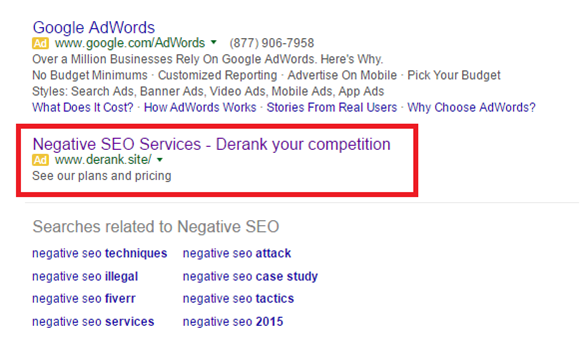 May 23, 2016: To assess the willingness of UK-based businesses to engage in negative SEO (the practice of deliberately causing links from “bad neighborhoods” to point to a competitor’s site), UK-based SEO agency ReBoot Online sent a fake e-mail campaign hawking such services.
May 23, 2016: To assess the willingness of UK-based businesses to engage in negative SEO (the practice of deliberately causing links from “bad neighborhoods” to point to a competitor’s site), UK-based SEO agency ReBoot Online sent a fake e-mail campaign hawking such services.
84 businesses owners, including plumbers, lawyers, accountants, and IT service providers were approached. Each received an email offering to make competitor sites “disappear from the first page of Google results for a period of six months, resulting in your site being bumped up accordingly in the Google rankings. In some cases, your competitor’s site will not return at all and in most cases, they will disappear for longer than 3 months.”
The email disclosed the two methods to be used to competing sites “disappear:
- Establishing thousands of low quality spammy links from some of the shadiest corners of the internet and…
- A well-established method of content duplication and distribution we have developed.
61 businesses replied to the e-mail – an amazingly high (72 percent) CTR. 13 rejected it outright, but 48 either wanted to know more or were willing to plunge in. 29 accepted the offer and asked how they might pay for these services.
ReBoot Online’s survey was too small to constitute a scientifically valid sample, but it’s still troubling. Reports of negative SEO attacks appear frequently in SEO forums. Many SEO agencies specialize not in link building, but in link removal. And it appears that Google is largely powerless to wipe out the tactic completely. Recently, Google’s John Meuller acknowledged that “it’s a tricky situation and not something where I’d say we can guarantee that we always get it 100% right.”
Negative SEO is alive and apparently well
Google’s anti-spam team has long been aware that Negative SEO could be used to “frame” unsuspecting sites. In 2012, former anti-spam chief Matt Cutts said that while most regular “Mom and Pop” small businesses likely had no need to fear such a frame, people in “super competitive, poker/casino type of niches” had more to worry about.
Here’s Cutts on Negative SEO, December 12, 2012
Google’s technology solution, which Cutts discusses, was the Disavow Tool, which lets webmasters tell Google to ignore suspect links. And while this tool has been productively employed by many thousands of webmasters to keep Negative SEO at bay (as well as to protect against possible Penguin penalties), it appears that vulnerabilities remain today. And it’s interesting that none of the businesses surveyed by Reboot Online were in “poker/casino” type of niches. In fact, many of them appeared to be in “Mom and Pop” small business categories – exactly the kind of businesses that Matt Cutts stated weren’t likely to be affected by the Negative SEO tactic.
Today, you can don’t have to look hard to find Negative SEO providers. In fact you can even – paradoxically – find Negative SEO ads on Google (just type in “Negative SEO” and study the paid listings).

One website offering such services is a company called www.derank.site which ran the ad above, and offers to “Make Websites Disappear: Exploit Search Engine Algorithms to Hide Problem Sites.”
Doing so, according to the site, is accomplished by creating “hundreds of thousands to millions of backlinks (as well as other signals) that communicate to the search engine that the target site must be de-ranked or de-indexed altogether.”
The site listed a number of packages. At the low end ($75.00), the “Strike” package offered 100,000 negative backlinks, plus “negative social signals;” at the high end, the $450 “Obliterate” package offered 2,000,000 negative backlinks, plus 10 “devastating” links. Results are promised “in as little as one week to one month, although the site tantalizingly suggested that customers could “start seeing rankings drops the next day.”
Given the brazenness of this pitch — and the apparently widespread interest in the tactic on the part of business — it’s quite obvious that Negative SEO is alive and well – on both sides of the Atlantic.
Fighting back against Negative SEO
Google’s Disavow Tool remains the single best defense for those who believe they may be victim of an SEO attack. It’s a direct channel to Google that effectively warns the search engine to disregard undesirable links.
But using it effectively means continually monitoring Search Console to spot bad URLs, , which can be a lot of work for sites with many inbound links. Webmasters need to be wary of links coming in from suspect TLDs – especially from foreign nations where their firms do no business. If you see this happening, fire up the Disavow Tool and disavow them.
Unfortunately, taking steps to negate Negative SEO attacks solves less than half of the problem. Without getting to the root of it – the Negative SEO providers – each webmaster must back fall on his/her own resources, which are often limited.
Google’s methods of detecting Negative SEO attacks aren’t perfect by any means, nor are they expected to be. But because Negative SEO tactic is – or should be considered to be – a particularly noxious type of “link scheme” prohibited by its Webmaster Guidelines, penalties for providers should be quick, severe, and permanent. Only through a relentless effort to ferret out these bad actors can this noxious tactic be deterred. Let us hope that that Google can bring more of its algorithmic muscle and AI to bear on this important issue
- 10 Mistakes to Avoid When Using QR Codes for Marketing - September 20, 2023
- Kevin Lee on How AI Changes the SEO Landscape - August 31, 2023
- The Power of Compound Marketing: Kevin Lee Presents @ 1MediaWorld 2023 Global Conference - March 7, 2023
